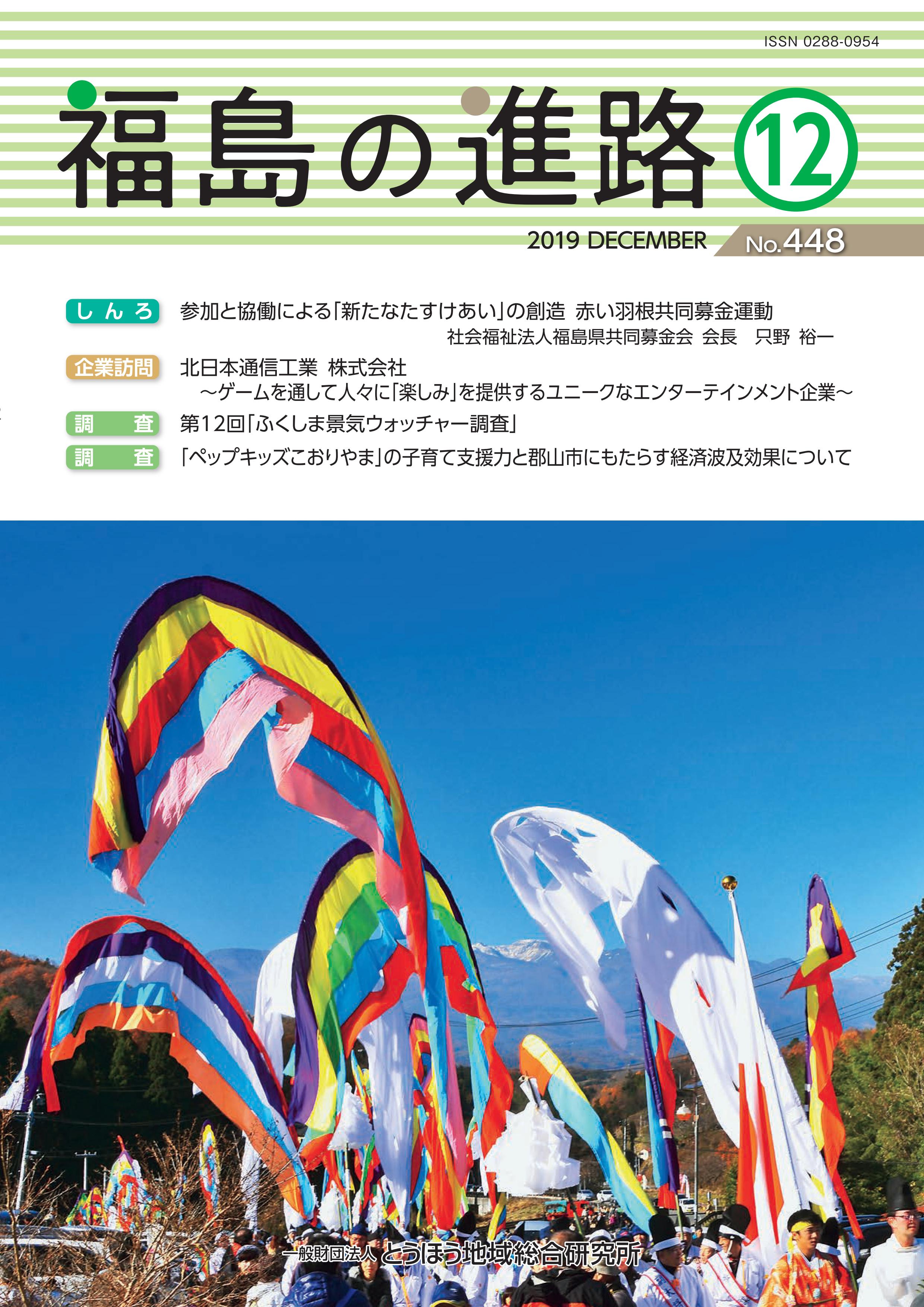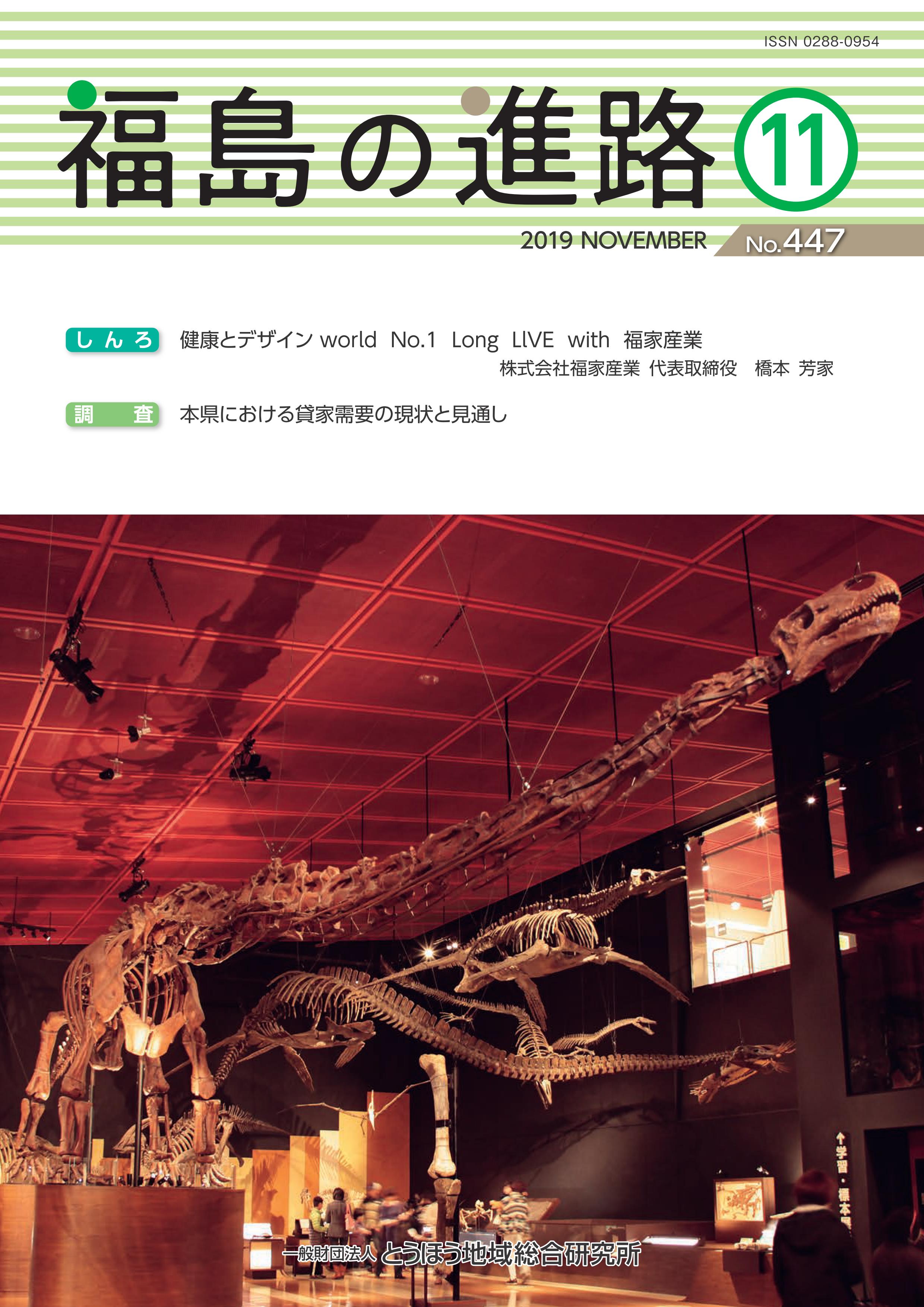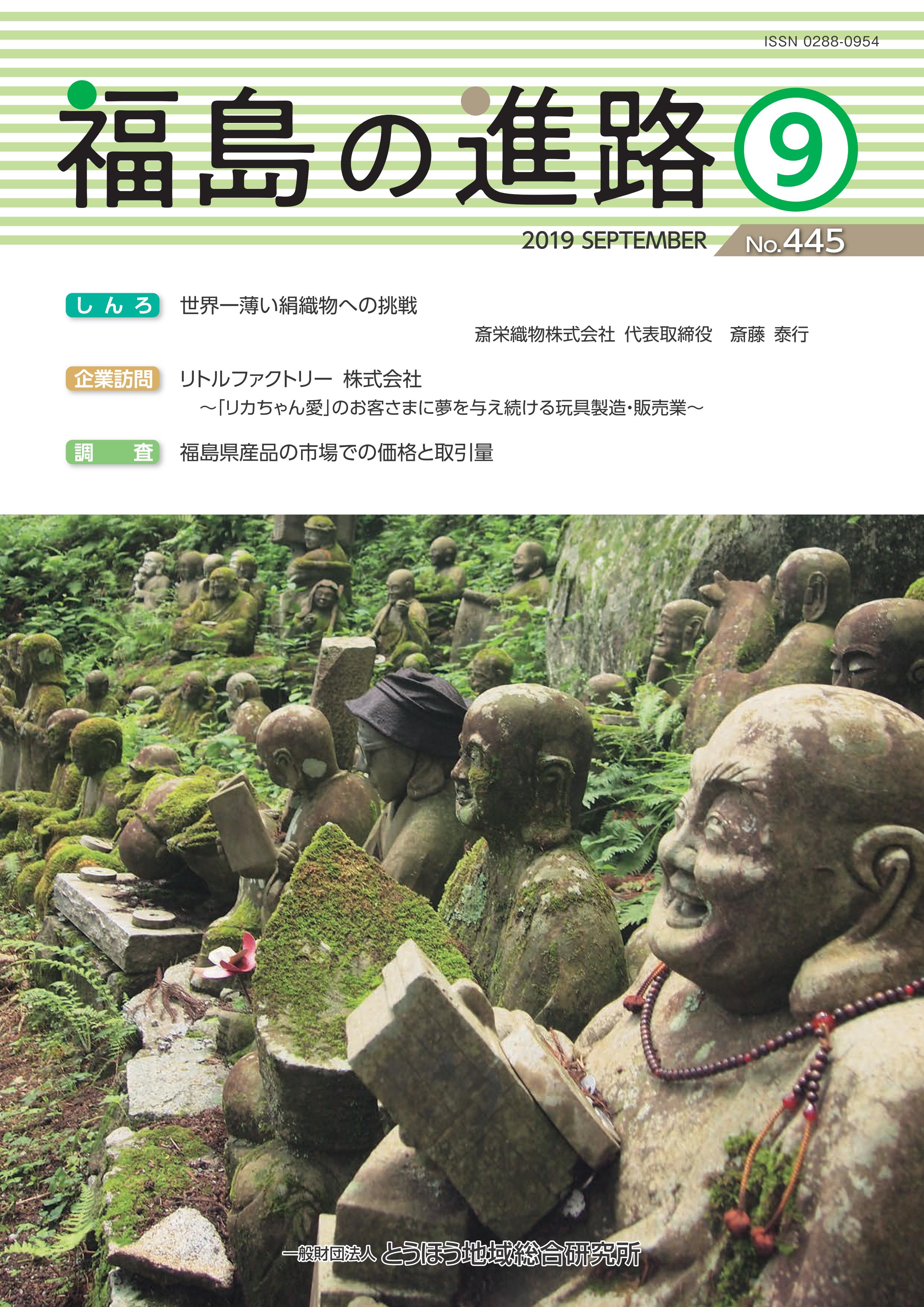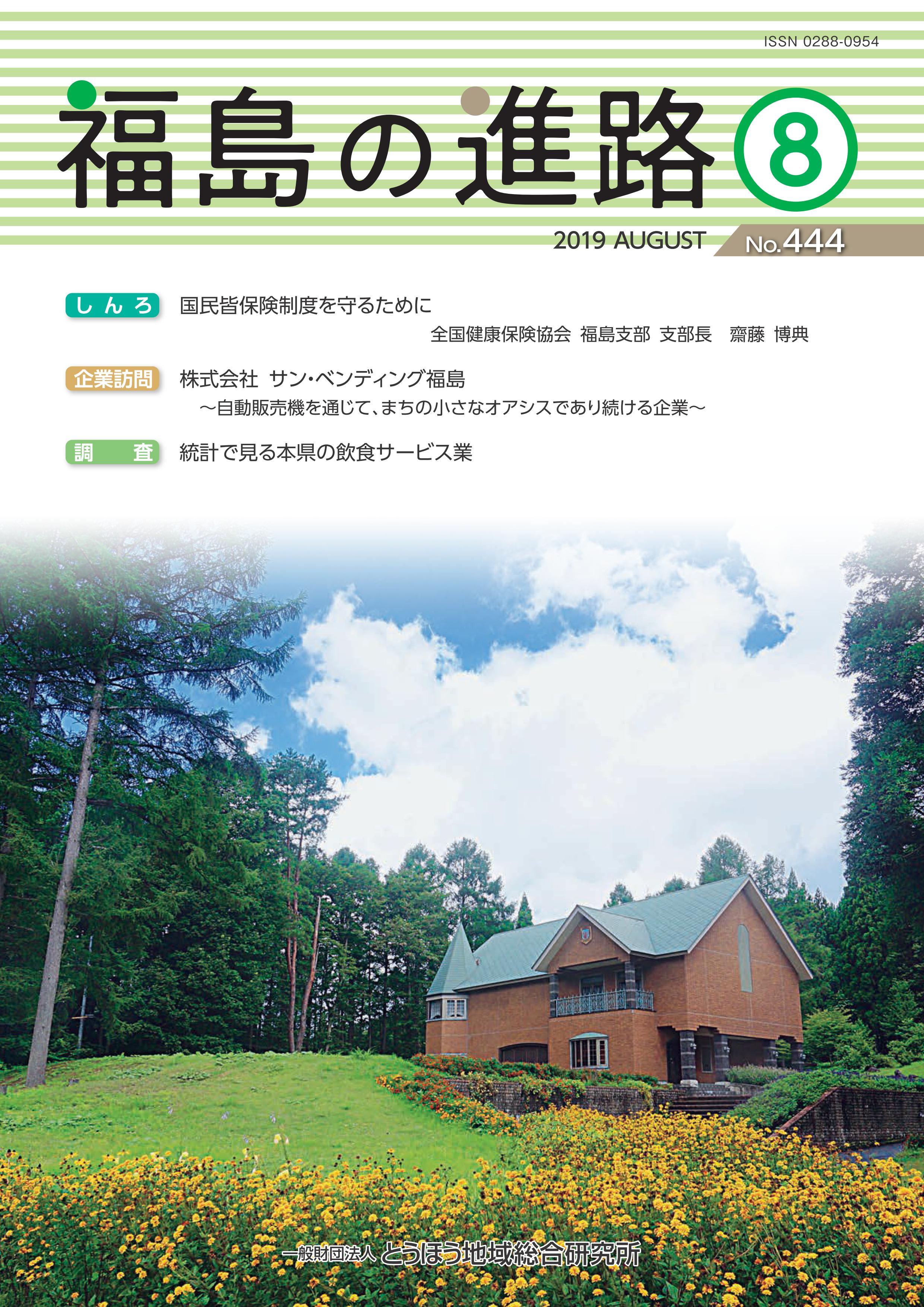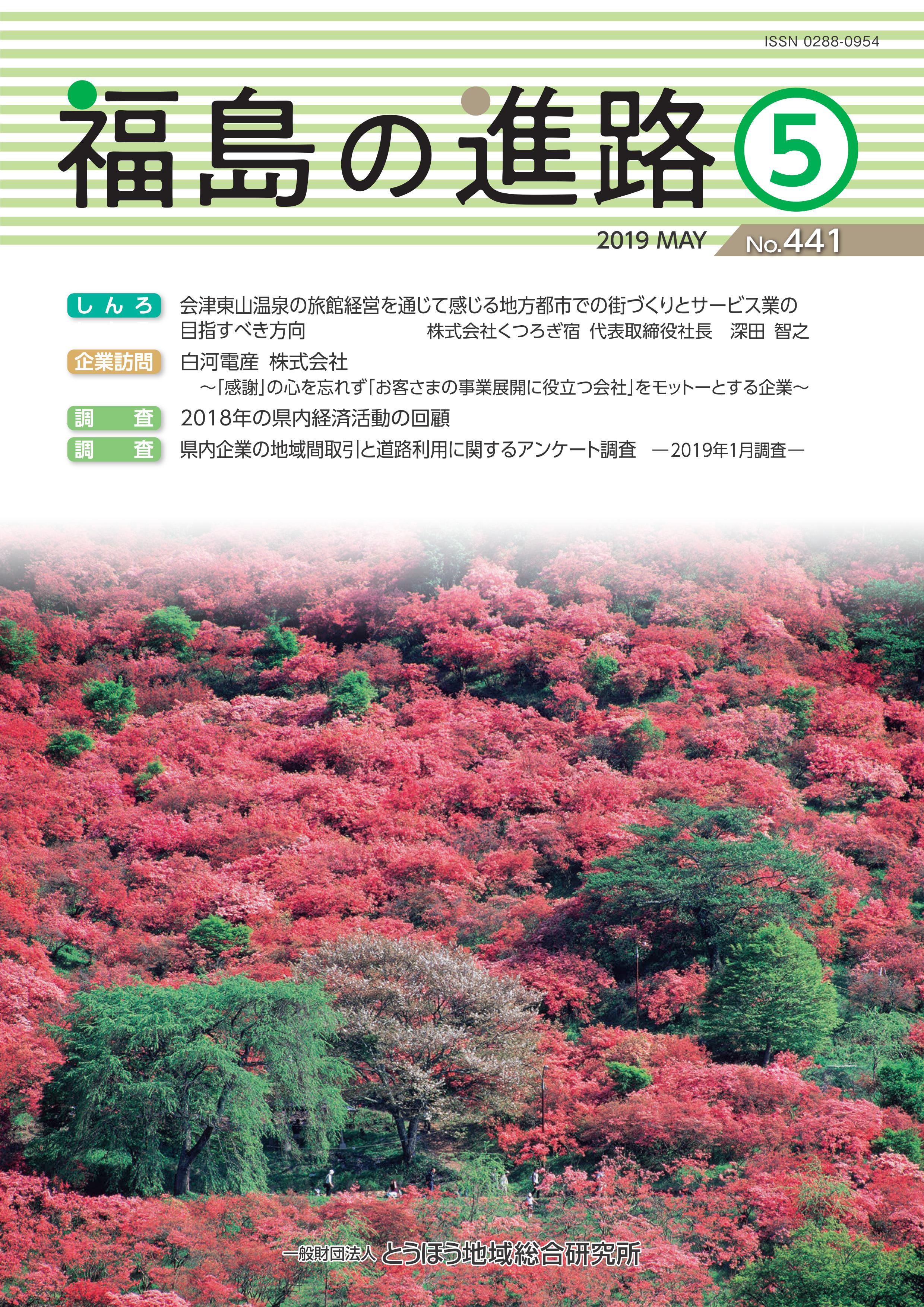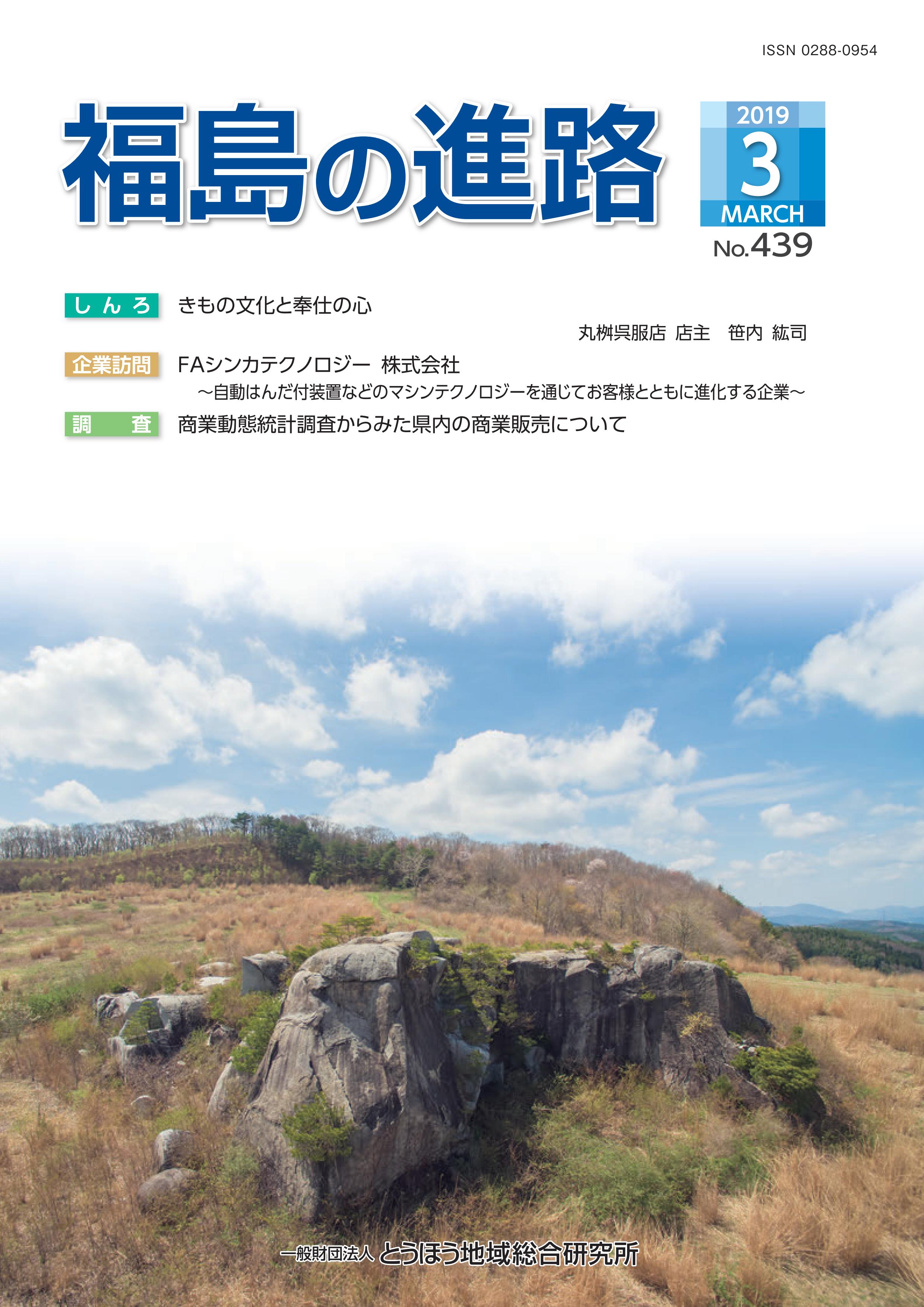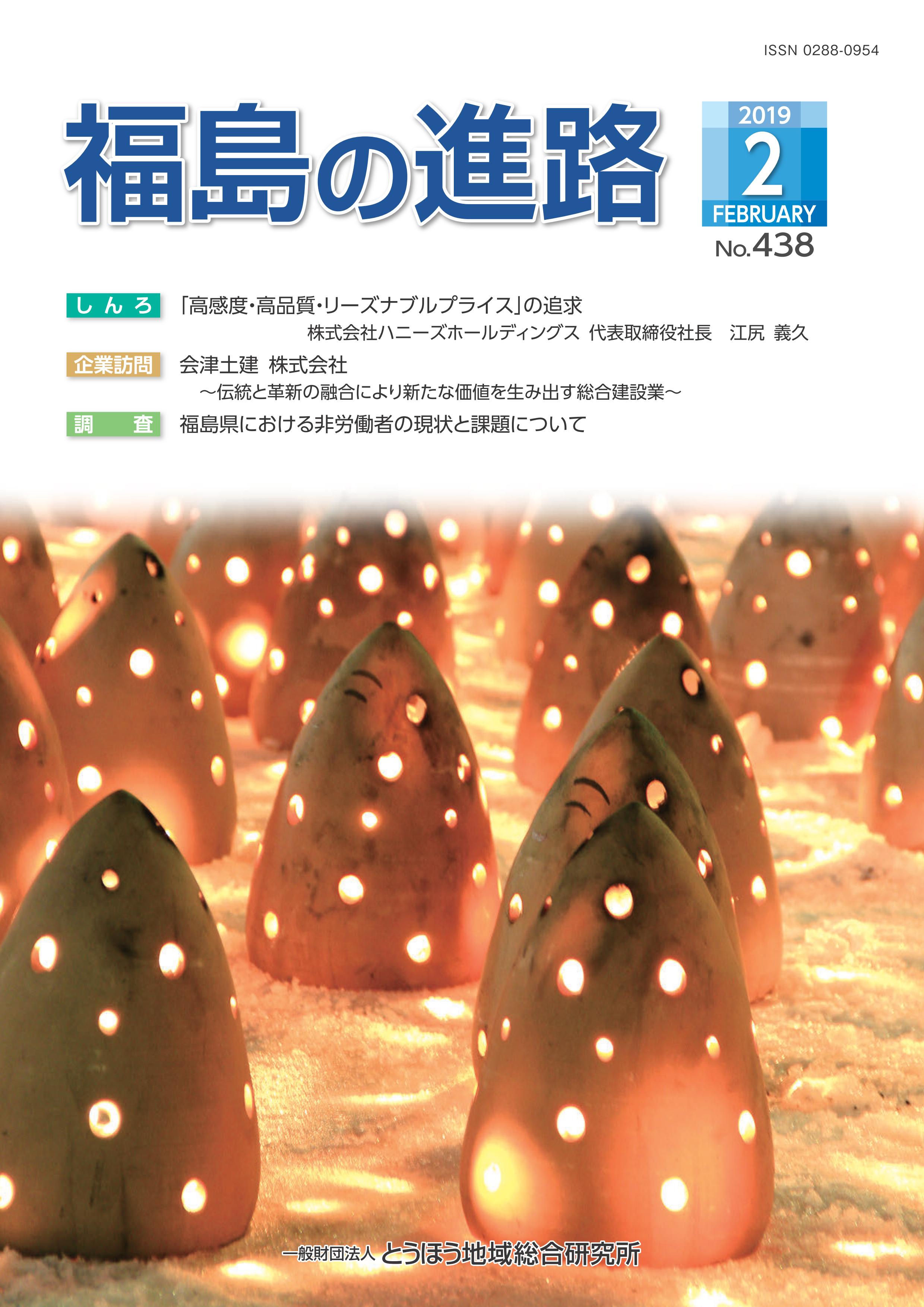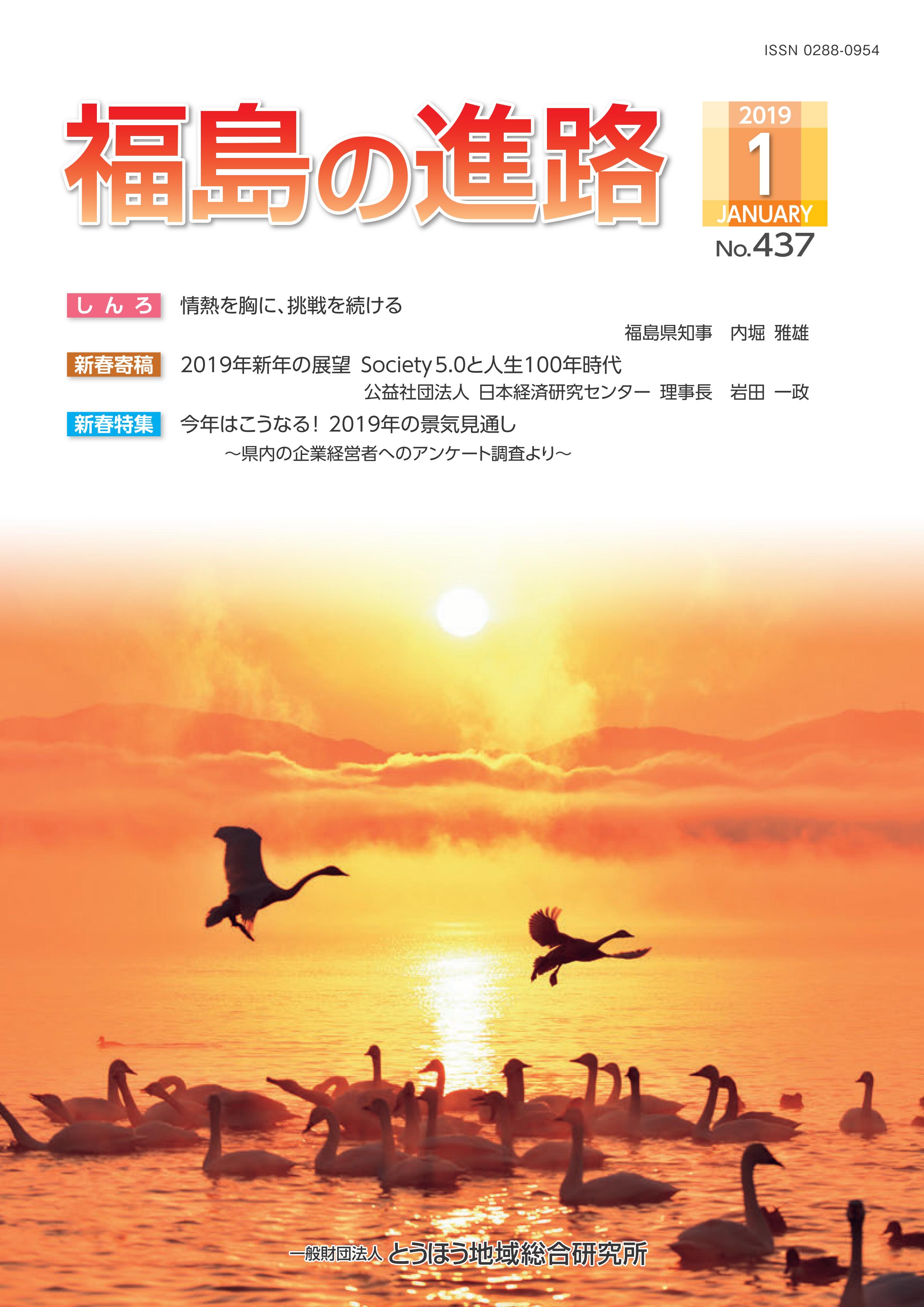「福島の進路」表紙掲載の観光スポット
Fukushima Tourist Information ~Places to Go in Fukushima~
Look at pictures on the cover of our monthly “Fukushima-no-Shinro”
最新号の表紙URLを貼り付けて下さい。
当研究所では福島県内への観光客誘致やインバウンド促進支援の観点から、毎月、機関誌「福島の進路」の表紙に県内の観光スポットや季節ごとの美しい風景を紹介しています。英語でも発信しています。
Tourist Information: Sightseeing in Fukushima
On the cover of our monthly journal ”Fukushima-no-Shinro,” literally “Fukushima’s Course”, we introduce various sightseeing spots or beautiful landscapes in Fukushima Prefecture every month.
12月号の表紙
木幡の幡祭り【二本松市】
木幡の幡祭りは、二本松市木幡で毎年12月最初の日曜日に行われるお祭りです。青森県の岩木山神振祭(しんじんさい)や長野県の岳の幟(たけののぼり)と並んで「日本三大旗祭り」の一つとも言われ、国の重要無形民俗文化財に指定されています。この祭りは11世紀の前九年の役に由来するものと言い伝えられています。戦いに敗れた軍勢(軍旗は白い旗)がわずか数騎で木幡山に立てこもったところ、一夜にして降り積もった雪で山が白くなりました。これを見た敵の軍勢は、雪を相手の白旗に見間違えて退却して行ったという故事により、現在も幡祭りとして伝わっているのです。この色とりどりの大幡をなびかせて歩くさまは、青空にくっきりと映え素晴らしいですよ。
【アクセス:東北自動車道二本松ICより車で約30分】
December Edition
Kohata Flag Festival, Nihonmatsu City
The Kohata Flag Festival is held on the first Sunday of December every year.
It is said to be one of the Three Flag Festivals of Japan, along with Mt.Iwaki’s Shinjin Festival in Aomori Prefecture and the Take-no-Nobori Festival in Nagano Prefecture. This flag festival in Nihonmatsu City is designated as a National Important Intangible Folk Cultural Asset. They say the festival originated during a war in the mid-11th century. Only a few warriors of the defeated troops, whose flag color was white, retreated to Mt.Kohata. Their enemy mistook the mountain covered with overnight snow for the countless opponents’flags, which made them retreat. The festival has been handed down to us from this old legend. It is awesome to see a group of people marching with colorful large flags flying in the beautiful winter blue sky.
【Directions:Approx.30 min by car from Nihonmatsu IC, Tohoku Expressway】
Location of the Spots
| Number on the Map | Month | Location |
|---|---|---|
| 1 | January | Inawashiro Town |
| 2 | February | Aizu-Wakamatsu City |
| 3 | March | Iwaki City |
| 4 | April | Fukushima City |
| 5 | May | Hanawa Town |
| 6 | June | Tamura City |
| 7 | July | Aizu-Misato Town |
| 8 | August | Kaneyama Town |
| 9 | September | Ono Town |
| 10 | October | Showa Village |
| 11 | November | Iwaki City |
| 12 | December | Nihonmatsu City |
バックナンバー
Back Numbers
ここの下にtoggleを追加してください。
11月号の表紙
石炭・化石館 ほるる【いわき市】
いわき市湯本駅の近くにある「石炭・化石館」は常磐炭鉱の歴史(=昭和の歴史)と太古時代の化石のミュージアムで、「ほるる」の愛称で親しまれています。1984年に開設されたこの施設には、常磐炭田の採掘現場をリアルに再現した模擬坑道が展示されています。市内各地で発見された世界的に貴重な化石も展示されています。入り口を入ると、いわき市で高校生が発見したフタバサウルス・スズキイが皆様をお迎えします。楽しみながら学べる施設です。恐竜の化石は驚きですよ。さあ、みんなで行きましょう!
【アクセス:JR湯本駅より徒歩約10分/常磐道いわき湯本ICより車で約10分】
November Edition
Museum of Coal Mine & Fossil, Iwaki City
The Coal Mine & Fossil Museum, dubbed “Horuru,” is located near Yumoto Station in Iwaki City. We can say that it is also a museum displaying the things from the Showa Era and the ancient times. It was opened in 1984 and exhibits elaborate mock coal mines of the Joban Mine which flourished until the middle of the Showa Era (around 1955). You can also find worldwide valuable fossils which were found across the city. When you enter the museum, a huge replica of dinosaur bones welcomes you. It displays the bones of “Futabasaurus Suzukii,” which was found by a high school student in 1968 in Iwaki City. There, you can enjoy learning a lot about mines and fossils. Above all, the dinosaur bones are amazing. Let’s go to Horuru!
【Directions:Approx.10 min on foot from JR Yumoto Station/Approx.
10 min by car from Iwaki-Yumoto IC, Joban Expressway】
10月号の表紙
喰丸小(くいまるしょう)【昭和村】
福島県の西部に位置する昭和村は、「からむし織の里」として知られています。村の中心部国道400号線沿いに喰丸小があります。1980年に廃校となった喰丸小学校の校舎は解体されることが決まっていましたが、その後映画撮影の舞台となり、全国からファンが集まるようになりました。昭和時代の風景を懐かしむ人々が集まってきたのです。村は校舎の保存を決定、改修資金を集めました。校庭に育つシンボルの大イチョウとともに、木造2階建ての校舎は、2018年4月に、交流・観光の拠点施設「喰丸小」として生まれ変わりました。これから秋も深まると、色づいたイチョウの落ち葉で一面が黄色いじゅうたんとなります。昭和村に来て、「昭和の時代」を思いめぐらすのもいいと思いませんか?
【アクセス:JR会津川口駅より国道400号経由 車で約25分】
October Edition
Kuimaru-sho, Showa Village
Showa Village, located in the western part of Fukushima Prefecture, is known as the home of“Karamushi-ori”which is local woven fabrics. In the center of the village, Kuimaru-sho lies along the Route 400. Kuimaru Elementary School was closed in 1980, and the building was to be destroyed. However, the place became a filming location, which afterwards attracted a lot of movie fans across Japan. They were people who longed for the scenery and landscapes of the Showa Era. Then the village office reversed the former decision and decide to protect the building. They collected money for its renovation. Together with a symbolic huge ginkgo tree, the two-story school building was born again as Kuimaru-sho, a base facility for local people to interact and to accept tourists. As autumn deepens, fallen leaves of the ginkgo tree covers the ground, which resembles a yellow carpet. Why don’t you come to Showa Village and think over the days of the Showa Era?
【Directions:Approx.25 min by car from JR Aizu-Kawaguchi Station, via Route 400】
9月号の表紙
満福寺の昭和羅漢【小野町】
福島県の中部に位置する小野町に東堂山(とうどうさん)があります。その中腹に建てられた満福寺(まんぷくじ)は807年に高僧徳一大師が建立した由緒あるお寺で、家畜繁盛・守護の御利益があると言われています。観音堂の近くには約500体の羅漢像が鎮座しています。羅漢は仏教用語で阿羅漢(あらはん)と言い、悟りに達した聖者のことを指します。しかし、ここにいる羅漢たちをよく見ると、札束を抱えてにんまりしている像、酒を飲んでいる像、マイクを持って歌っている像などユニークな個性ある(変な?)像たちがいます。実はすべて1985年以降に作られた像で、奉納した人の思いが込められているのです。ぜひここに来て羅漢像を観察してみてください。もしかしたら、自分にそっくりの像が見つかるかも知れませんよ!
【アクセス:磐越自動車道小野ICより車で約15分】
September Edition
Showa Rakan at Mampukuji Temple, Ono Town
Mt.Todo lies in Ono Town which is located in the middle of Fukushima Prefecture. Mampukuji Temple stands on the mountainside of Mt.Todo and is a temple with a long history. The temple was built in 807 by Tokuitsu, a high priest of the Heian Period, and is famous for answering prayers for prosperity and safety of livestock. There are more than 500 rakan statues sitting near Kannon-do of the temple. Rakan, or Arhan means a one who has gained insight into the true nature of existence and has achieved enlightenment. If we carefully look at these rakan in the picture, you’ll find them very unique or rather weird. Some are smiling complacently holding wads of bill notes, and others are drinking sake and singing with mikes in their hands. Actually, these statues were made after 1985, and they have their offerers’ desires and wishes. Why don’t you come and closely take a look at rakan? You might find a rakan statue which looks exactly like you.
【Directions:Approx.15 min by car from Ono IC, Ban-Etsu Expressway】
8月号の表紙
沼沢湖の妖精美術館【金山町】
福島県の西部に位置する金山町に沼沢湖があります。大蛇伝説を持つこのカルデラ湖は、森に囲まれた静かな湖で、「妖精の里」として知られています。湖畔には公園、キャンプ場が整備されており、日本で唯一の妖精美術館があります。日本の妖精研究の第一人者で、当美術館の館長の井村君江さんが世界中から収集した絵画・絵本・人形などの様々な作品が展示されています。また、8月第1土曜日、日曜日(今年は3日、4日)には「沼沢湖水まつり」が開催されます。夜の沼沢湖に花火とともに大蛇が現れ、地元の高校生らが協力して大蛇を退治するシーンが再現されます。会場ではほかにもステージショーや出店もありますよ!
【アクセス:磐越自動車道会津坂下ICより車で約50分】
August Edition
Fairy Museum at Lake Numazawa, Kaneyama Town
Kaneyama Town is located in the most western area of Fukushima Prefecture. In the town, Numazawa Lake lies quietly in the forest. This caldera lake has a legend of a big snake and is known as the home of fairies. At the lakeshore, there is the Fairy Museum, as well as parks and camping sites. The museum, the only fairy-related museum in Japan, exhibits a lot of paintings, picture books and dolls collected throughout the world. The exhibition mainly consists of a variety of art works collected by Ms. Kimie Imura, the director of the museum and a leading authority on fairy study in Japan. The Numazawa Lake Festival is held on the first Saturday and Sunday of August, being 3rd and 4th this year. At night a giant snake appears on the lake surface against the background of summer fireworks, and then “soldiers”including local high school students fight and slay the big snake. Besides, you can enjoy stage shows as well as stalls at the festival.
【Directions:Approx.50 min by car from Aizu-Bange IC, Ban-Etsu Expressway】
7月号の表紙
伊佐須美神社の御田植祭【会津美里町】
伊佐須美神社は、会津地方の総鎮守として歴史が古く、殖産興業の守護神として名高く信仰を集めている神社です。毎年7月11日から13日まで開催される御田植祭(おたうえまつり)は、その年の豊作を祈願する祭りです。この田植祭は「昼田植」として、伊勢神宮の「朝田植」、熱田神宮の「夕田植」とともに日本三田植と呼ばれています。また、今年3月には国の重要無形民俗文化財に指定された、由緒ある祭りです。写真は、地元の中学生が扮する早乙女による田植式の様子です。ぜひこのお祭りを見に来てください!
【アクセス:磐越自動車道会津若松ICより車で約30分】
July Edition
Rice-Planting Festival at Isasumi Shrine, Aizu-Misato Town
Isasumi Shrine in Aizu-Misato is a shrine with a long history as the chief Shinto shrine of the Aizu District. It is dedicated to the local guardian deity of farming and industrial development. From July 11 to 13 every year, people hold the ”Otaue Matsuri,” which is a rice-planting festival in Japanese, and pray for the harvest of the year. This rice-planting ritual is also called the Day Planting, and is considered as one of the Three Rice Planting Festivals in Japan, along with the Morning Planting at Ise Shrine in Mie prefecture and the Evening Planting at Atsuta Shrine in Aichi prefecture. Being so venerable, Isasumi Shrine’s Otaue Festival was designated as a national important intangible folk cultural property this March. The picture on the cover shows young women, called Saotome, are planting rice seedlings at the Taue ritual. Actually, local junior high school students are dressed in rice planters. Please come and see the festival!
【Directions:Approx.30 min by car from Aizu-Wakamatsu IC, Ban-Etsu Expressway】
6月号の表紙
おおたかどや山標準電波送信所【田村市】
6月10日は「時の記念日」です。時間の大切さを考えるのに良い機会かも知れません。日本では電波時計がかなり普及していますが、電波時計に正確な時を伝えているのが標準電波送信所なのです。この電波はどこから発信されているか知っていますか?日本では送信所が2か所あって、そのうちの1か所は福島県にあるのです。もう1か所は九州の佐賀県にあります。福島県には、田村市都路町と川内村にまたがる大鷹鳥谷山(おおたかどややま)の山頂付近に標準電波送信所があります。半径約1,000km、北海道から九州の一部まで広範囲をカバーしています。1999年6月に開局した当送信所は、開局20周年を迎えます。
【アクセス:田村市都路町古道地区へは磐越自動車道船引三春ICより国道288号・399号経由 車で約45分】
June Edition
Standard Radio Wave Tranmitter in Fukushima, Tamura City
June 10 is the Time Day in Japan. I think it’s good to think about the importance of time! Radio clocks are now widely used in Japan. It is the Standard Radio Wave Transmitter that tells an accurate time to radio clocks. Do you know where radio waves come from? Actually, there are two wave transmission stations in Japan, one of which is located in Fukushima Prefecture. The other is in Saga Prefecture, Kyushu. In Fukushima Prefecture, there lies a wave station around the top of Mt. Otakadoya situated on the border between Miyakoji-machi, Tamura City and Kawauchi Village. The wave covers an area with a radius of 1,000 km, from Hokkaido to a part of Kyushu. The station opened in 1999, and so the 20th anniversary is to be celebrated on June 10 this year.
【Directions: To Furumichi District, Miyakoji-machi, Tamura City, approx.45 min by car from Funehiki Miharu IC, Ban-Etsu Expressway via Route 288 & 399】
5月号の表紙
風呂山公園【塙町】
中通り地方の南部に位置する塙町は、比較的温暖な気候で住みやすい町です。町中心地の南、山の傾斜地にある風呂山公園には山つつじが一面に広がっています。日露戦争の荒廃した世の中を明るくしようと、1912年に当時の青年会のメンバーが植えたものです。花が咲く5月には、つつじが山を鮮やかな紅色に染めます。先人の思いが詰まったこの公園は町民の憩いの場として親しまれています。ところで、1912年は大正元年にあたります。令和元年が始まった今、風呂山公園のつつじをみながら、100年以上前の出来事に思いを馳せるのもいいと思いませんか?
【アクセス:水郡線磐城塙駅より徒歩10分】
May Edition
Furoyama Park, Hanawa Town
Hanawa Town lies in the southernmost part of Fukushima Prefecture and has a warm climate, which makes the town a good place to live. At Furoyama Park located on steep slopes just south of the central town, you can see a hill covered with thousands of mountain azaleas in bloom. The azaleas were planted by the members of the town’s Young Men Association in 1912, in order to make the world brighter during the social unrest after the Russo-Japanese War (1904-1905). Around May when the azalea blossoms are in bloom, the hill is colored in vivid red. The people in the town love and cherish this park filled with thoughts of their predecessors. By the way, the year 1912 falls on the first year of Taisho (大正) era. Now, the new era of Reiwa (令和) has just begun. I think it’s good to think about things that happened more than 100 years ago, appreciating the azaleas of Furoyama Park.
【Directions: Approx.10 min on foot from Iwaki-Hanawa Station, Suigun Line】
4月号の表紙
花ももの里 【福島市】
福島市を代表する飯坂温泉、その西部に位置する舘の山公園の北東部に「花ももの里」があります。宇都宮大学農学部と飯坂温泉観光協会の共同研究の成果として、2007年にオープンした花の公園です。現在は80アールに広がった敷地に世界各地から集められた花桃(ハナモモ)の木が約300本植樹され、4月初旬から5月初旬にかけて約1か月間、赤や白やピンクの様々な品種の花が見事に咲き誇ります。桃畑が満開になる前には、福島市内には花見山をはじめ、たくさんの桜の名所もあります。花見をして円盤餃子を食べて温泉にも入れば、福島の春を完璧に楽しめますよ!
【アクセス:東北自動車道福島飯坂ICより車で約10分または飯坂温泉駅より徒歩20分】
April Edition
Hanamomo-no-Sato, Fukushima City
Iizaka Onsen is the most famous hot spring resort in Fukushima City. Hanamomo-no-Sato, literally peach blossoms’ village, lies northeast of Tateno-yama Park, which is located west of Iizaka Onsen Town. The blossom garden opened in 2007 as the fruit of the labor of both the Iizaka Onsen Tourism Agency and Utsunomiya University, who had worked together on peach blossoms. About 300 peach trees collected from all over the world have been planted on the lot, which now has extended to over 8,000 square meters, or 2 acres. From early April to early May, the trees have red, white and pink blossoms of various kinds. Before the high season of peach blossoms, Fukushima City area is covered with cherry blossoms in full bloom. You can visit many flower-viewing spots such as Hanami-yama during this period. Doing the flowers-viewing, eating local specialty gyoza and taking a bath at the hot springs mean that you are enjoying the spring in Fukushima to the max!
【Directions: Approx.10 min by car from Fukushima Iizaka IC, Tohoku Expressway, or 20 min on foot from Iizaka-Onsen Station 】
3月号の表紙
宇宙岩 【いわき市】
いわき市三和町差塩地区に一本毛欅(いっぽんぶな)という山があります。その山には「宇宙岩」と呼ばれる奇妙な岩がありますが、近くの道路には案内看板も出ていなく、知る人ぞ知るパワースポットです。小高い牧草地の頂上付近にこの巨石が鎮座しています。高さ10m、長さ5mはあろうかという大きな岩ですが、よく見ると岩を白いラインが数本走っています。これは誰かがペンキで描いたものではありません。石英などでできた自然物です。冬至にはその中の1本のライン上を朝日が昇るとか・・・。岩の上に上ることもできます。「いわきのエアーズロック」宇宙岩は一見の価値あり!
【アクセス:磐越自動車道いわき三和ICより車で約30分】
March Edition
Space Rock,Iwaki City
In the Saiso District, Miwa, Iwaki City there is a mysterious rock called “Space Rock” on Ippon Buna Mountain. It is a kind of secret power spot which is hard to find because there is no signpost along the nearby roads. There sits this huge rock near the top of a slightly elevated pasture, and it seems 10 meters in height and 5 meters in length. If you take a closer look at it, you can see some white lines running on its surface. They are not painted on by someone but are natural, made from materials like quartz. It is said the sun rises along one of these vertical lines of the rock on the Winter Solstice. You can also climb on the top. This space rock, “Ayers Rock in Iwaki,” is really worth seeing!
【Directions: Approx.30 min by car from Iwaki-Miwa IC, Ban-Etsu Expressway】
2月号の表紙
会津絵ろうそくまつり 【会津若松市】
会津伝統工芸品のひとつである「会津絵ろうそく」は、今から500年以上前の室町時代に始まったと言われています。1本1本に菊やボタン、フジなどの草花が色鮮やかに描かれていて美しいので人気があります。この素晴らしい会津絵ろうそくをもっと知ってもらおうと2000年に始まったのが、「会津絵ろうそくまつり」です。冬の会津の夜を幻想的に照らす光を見ていると、過ぎ去った会津の長い歴史を偲ばれます。今年は記念すべき20回目で2月8日、9日の2日間開催され、鶴ヶ城公園、御薬園、会津若松駅、東山温泉など市内各所で無数のろうそくが灯されます。冬の会津にぜひおいでください!
【アクセス:鶴ヶ城へはJR会津若松駅より周遊バス「ハイカラさん」で約20分】
February Edition
Aizu Painted Candle Festival, Aizu-Wakamatsu City
Painted candles are traditional crafts in Aizu, which are said to have originated in the Muromachi Period, over 500 years ago. Flowers such as chrysanthemums, peonies, and wisterias are brilliantly painted by hand on every candle. So, the painted candles, known as “Aizu E-rosoku,”are popular for their exquisite beauty. The Aizu Candle Festival began in 2000 to let people know more about the crafts. Painted candles are lit and set in lanterns on the snowy ground. The fantastic illuminations which light the night around in Aizu-Wakamatsu City remind us of the city’s long history. This year marks the memorable 20th year of this event, which will be held on February 8 and 9. More than tens of thousands of candles will be lit during these two days at several places including Tsurugajo Castle Park, Oyakuen Garden, Aizu-Wakamatsu Station, and Higashiyama Onsen. Visit Aizu-Wakamatsu City in the winter!
【Directions:To Tsurugajo Castle Approx.20 min by Town Bus “Haikara-san” from JR Aizu-Wakamatsu Station】
1月号の表紙
白鳥浜:猪苗代湖の白鳥 【猪苗代町】
猪苗代湖には毎年10月頃から翌年4月頃まで「冬の使者」白鳥が訪れます。湖の北岸、長浜から志田浜にかけて飛来し、白鳥浜と呼ばれる最大の飛来地にはピーク時3,000羽を超えます。天気の良い日には、白鳥と猪苗代湖と磐梯山のコラボレーションによる絶景が楽しめ、一帯は写真撮影の有名スポットになっています。飛来する白鳥の多くは「コハクチョウ」という種類です。また、近くには猪苗代に注ぐ長瀬川河口付近で、波しぶきが樹木に氷結し付着してできる氷の芸術「しぶき氷」も見られます。猪苗代湖には冬しか見られない素晴らしいものがありますよ!
【アクセス:磐越自動車道猪苗代磐梯高原ICより車で約10分】
January Edition
Hakucho-hama:Swans at Lake Inawashiro, Inawashiro Town
From around October to next April, Lake Inawashiro becomes a landing zone for swans, which are often called messengers of winter in Japan. The swans fly to around the Nagahama and Shidahama area, the northern coast of the lake. Most of the swans flying onto the lake are called tundra swans. At their peak, the number of swans amounts to more than 3,000. On a fine day, you can enjoy an exquisite winter view which is seen in collaboration with Lake Inawashiro and Mt.Bandai. There is a popular spot called Hakucho-hama, literally a swan beach, which is the largest landing zone of the lake. Now the area is becoming a crowded spot for taking photos. Near Hakucho-hama, at the mouth of the Nagase River which flows into Lake Inawashiro, you can see a magnificent nature art of ice made by water-spray from waves stuck to tree branches. In Inawashiro, there are wonderful things you should not miss in winter!
【Directions: Approx.10 min by car from Inawashiro Bandai-kogen IC, Ban-Etsu Expressway】

